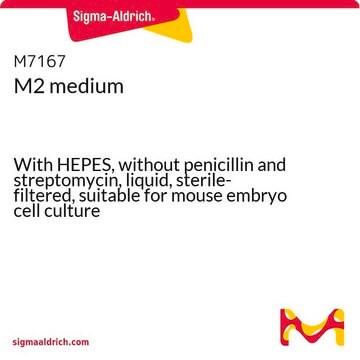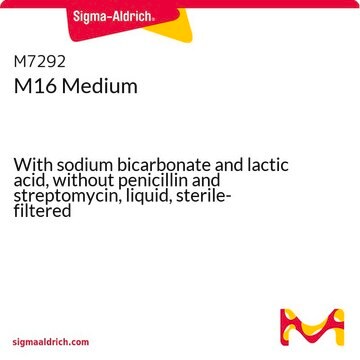Recommended Products
sterility
non-sterile
form
light oil
storage condition
protect from light
refractive index
n20/D 1.467 (lit.)
density
0.84 g/mL at 25 °C (lit.)
format
neat
InChI key
AEOVEGJBKQQFOP-DDVLFWKVSA-L
Looking for similar products? Visit Product Comparison Guide
Application
Mineral oil has been used as an overlay in microdrop embryo cultures.
Caution
This product is not sterile. Mineral oil is difficult to sterilize. It can only be sterilized by careful filtration of the warmed oil. It is assumed antibiotics will be added to the cell culture medium. Otherwise, Prod. No. M5310 should be used, as it is sterile filtered.
Analysis Note
This material is tested as an overlay in microdrop embryo cultures. (All embryo tested materials are tested using mouse embryos.) Typically BCF1 x BDF1 hybrids are used. The oil is primarily used to prevent evaporation of the medium, particiularly when performing embryo manipulations.1 The procedure is as follows: 1-cell (BCF1 X BDF1) embryos were cultured in triplicate microdrops of embryo-tested HTF (Human Tubal Fluid) medium supplemented with 0.4% BSA. For a valid assay, at least 70% of 1-cell stage control embryos must develop to the blastocyst stage within 96 hours. For product release, at least 80% of 1-cell stage test embryos must develop to the blastocyst stage within 96 hours with the tested material.
comparable product
Product No.
Description
Pricing
Storage Class Code
10 - Combustible liquids
WGK
WGK 1
Flash Point(F)
No data available
Flash Point(C)
No data available
Personal Protective Equipment
dust mask type N95 (US), Eyeshields, Gloves
Certificates of Analysis (COA)
Search for Certificates of Analysis (COA) by entering the products Lot/Batch Number. Lot and Batch Numbers can be found on a product’s label following the words ‘Lot’ or ‘Batch’.
Already Own This Product?
Find documentation for the products that you have recently purchased in the Document Library.
Customers Also Viewed
TIE: A Method to Electroporate Long DNA Templates into Preimplantation Embryos for CRISPR-Cas9 Gene Editing
Bagheri H, et al.
The CRISPR journal, 1(3), 223-229 (2018)
Minoru Kubo et al.
Nucleic acids research, 47(9), 4539-4553 (2019-03-16)
Next-generation sequencing technologies have made it possible to carry out transcriptome analysis at the single-cell level. Single-cell RNA-sequencing (scRNA-seq) data provide insights into cellular dynamics, including intercellular heterogeneity as well as inter- and intra-cellular fluctuations in gene expression that cannot
Insulin and branched-chain amino acid depletion during mouse preimplantation embryo culture programmes body weight gain and raised blood pressure during early postnatal life
Velazquez M
Biochimica et Biophysica Acta (BBA)-Molecular Basis of Disease, 1864(2), 590-600 (2018)
Production of a gonadotropin-releasing hormone 2 receptor knockdown (GNRHR2 KD) swine line
Desaulniers AT, et al.
Transgenic research, 26(4), 567-575 (2017)
Takaya Totsuka et al.
Scientific reports, 10(1), 6556-6556 (2020-04-18)
To study the functional differences between maternal and paternal genomes in mammalian development, embryos with only one parental genome are often used. Androgenetic embryos are produced by the removal of maternal chromosomes before or after fertilization by techniques that require
Our team of scientists has experience in all areas of research including Life Science, Material Science, Chemical Synthesis, Chromatography, Analytical and many others.
Contact Technical Service















